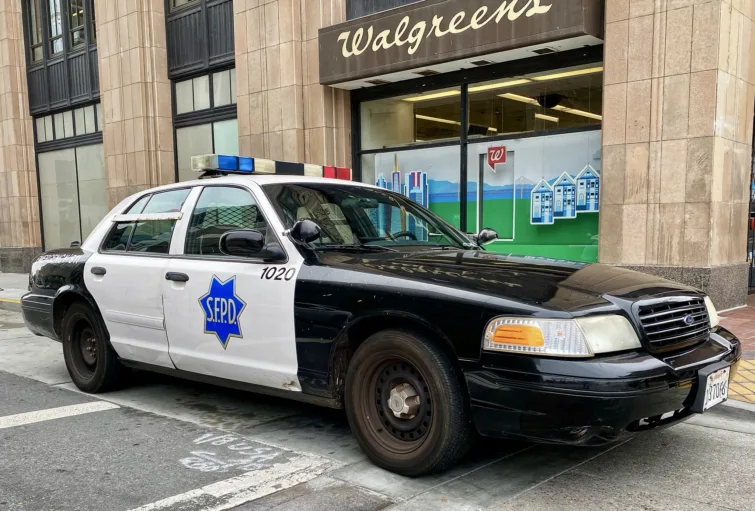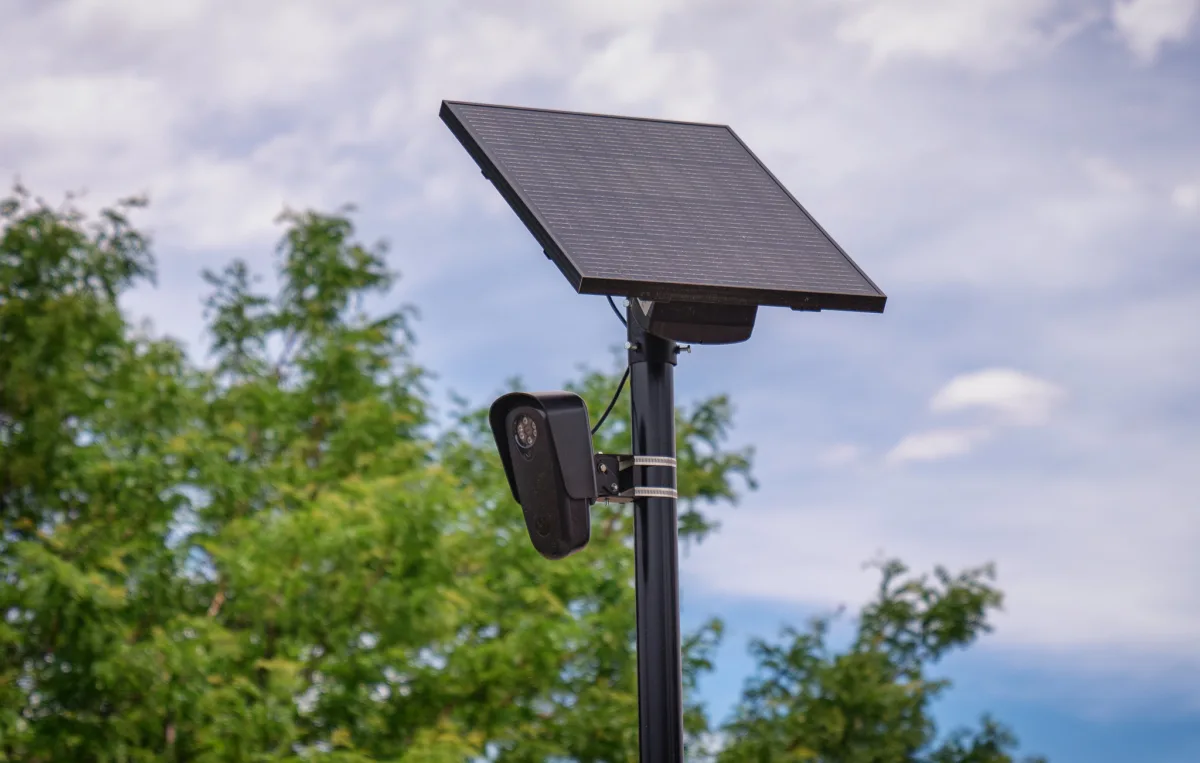Cops Used the Shoplifting Panic to Buy Tons of New Equipment
The “crime panic” was a myth. But an analysis by The Appeal shows the narrative helped local police buy facial recognition software, drones, license plate readers, social media surveillance tech, and more.

Retail theft has dominated headlines, earnings calls, and political rhetoric for the last few years. Television news shows loop seemingly endless clips of people shoplifting. CEO’s claimed that retail theft was constant in different stores, including Target, Dick’s Sporting Goods, and others, costing millions. The Department of Homeland Security warned that a surge of coordinated shoplifting—allegedly by groups selling the goods for cash or to fund other criminal acts—was the newest public safety threat.
Police then capitalized on the panic they helped gin up—around the country, and departments blanketed the press with statements claiming they somehow lacked the resources to stop or solve the problem.
According to a new analysis by The Appeal, the tactic paid off. California, Oregon, Illinois, and other states are now doling out money to police departments for retail theft investigations. California said it would give police over $242 million between 2023 to 2027. Illinois has awarded almost $15,000,000 over the past three years. And Oregon has allocated $5 million.
Grant requests from California reviewed by The Appeal reveal the police intend to build out a mass surveillance network to catch shoplifters.
The proposed dragnet includes automatic license plate readers, facial recognition software, real-time crime centers, and ample overtime funding for cops. Police are sharing access to their tech and data collected with each other, deepening the surveillance across their state. They’re also collaborating with retailers, integrating themselves into stores, and furthering the reach of police surveillance in private spaces.
The grants also reveal other technology and resources departments say they need that far exceed the needs of catching shoplifters:
- Cell Phone Interceptors: The Santa Clara Police Department requested $700,000 plus a $50,000 yearly licensing fee for a vehicle equipped with a StingRay cell phone-tracking device to intercept cell phone calls, texts, and location data. The department says the equipment will catch hardened criminals who go mobile. The department says it intends to use the StingRay at least 100 times yearly, citing other use cases, including corporate shareholder meetings and next year’s Super Bowl. The Ventura Sheriff’s Department is also purchasing one for $850,000.
- Bolstered K9 Units: Beverly Hills Police Department, a city already covered in surveillance technology, is buying an Electronic Storage Detection K9 to detect odors and chemicals from electronic devices. The dog costs $54,050, which includes kenneling and training.
- Social-Media Surveillance: Five California departments are purchasing subscriptions to social media surveillance software to monitor the dark web and track suspects. The most prevalent software is Israeli-created Cobwebs Technologies, which uses public cell phone and social media location data. The Hawthorne Police Department is taking it further by using Cobwebs with surveillance facial recognition software Clearview AI.
- Guns and tactical equipment: Multiple departments are getting new military equipment and weapons for retail theft operations, including rifles, shields, bulletproof vests, and night vision goggles. The Bakersfield Police Department claims retail crime will continue to grow without these resources.
- Fusion Center Cooperation: Citing a nexus between crimes, including organized retail theft and “terrorist activities,” the Petaluma Police Department budgeted $631,000 for three years to contract a full-time crime analysis from the Northern California Regional Intelligence Center (NCRIC). The NCRIC is part of a national network of fusion centers that connect local and state police departments with federal agencies, including the Federal Bureau of Investigation and the Department of Homeland Security, to share and gather intelligence on public safety threats. The NCRIC and 13 other agencies also recently created the Organized Retail Crime Incident and Reporting Exchange to provide a searchable and shared intelligence database, group chats, and crime-mapping using incident location data.

A Myth
A “crime surge” always means money for police, even if the spike in organized retail theft is a myth.
For a handful of years, the most widely cited data on organized retail theft came from the National Retail Federation (NRF) trade group, which claimed the practice was responsible for an eye-popping $45 billion in yearly losses. But, after numerous experts criticized the NRF’s data and said the group’s numbers were essentially fabricated, the NRF retracted its study in Dec. 2023.
From there, the narrative began to fall apart. Some retailers that used theft as an excuse for closures—such as Target—were debunked. In an earnings call, Walgreens Chief Financial Officer James Kehoe said his company exaggerated the impact theft had in his stores, saying “maybe we cried too much last year.” Some experts say retailers blamed shoplifting to cover up other internal flaws and profit losses. The NRF itself began adding caveats to the new data it publishes.
Neither police nor retailers can provide accurate data on organized retail crime because both lack a uniform means of capturing retail thefts and organized retail crime, the group’s 2024 retail crime survey said.
But the absence of facts hasn’t stopped police from getting more money—or surveillance companies from hawking new products.
In their 2023 grant request to the California Board of State and Community Corrections (BSCC), the Upland Police Department admitted it was hard to track or define “organized retail crime.”
“It is often difficult to tell which of these is driven by organized criminal elements and which are individual perpetrators,” the Southern California department said.
However, those issues didn’t stop UPD from asking for over $2 million to cover the creation of a retail theft task force. The funding includes the salaries and overtime of three police officers and one detective for three years.
Matthew Guariglia, a senior policy analyst with the Electronic Frontier Foundation, a digital civil liberties organization, told The Appeal that the national funding deluge is an example of mission creep.
“There’s an inciting incident that the public or store owners or police get worked up about, and to combat that, they build an infrastructure of surveillance that is so far outside of the scope of just addressing the original problem,” he said.
Guariglia said the more the public’s fears about crime grow, the easier it is for surveillance companies to profit. Rather than dealing with the complex root causes of theft or crime, politicians can just throw money at the problem.
Companies Cash In
Surveillance companies hoping to catch money on the other side spent millions lobbying local, state, and federal governments to pitch their technology as the silver bullet to organized retail theft.
Axon, which sells body cameras, Tasers, and real-time crime software, spent $376,000 from 2021 to 2024 lobbying the California legislature for retail theft legislation and funding for its technology. Automatic license plate reader company Flock spent more than $280,000 in California, including lobbying the Board of State and Community Corrections, the department responsible for overseeing retail theft grants. 3SI, which sells GPS trackers, offered to help police departments fill out their grant requests if they purchased the company’s tech.
Police, retailers, and tech companies rubbed elbows at industry conferences like the NRF Protect, which tells retailers they can “forge and strengthen vital public-private partnerships” with police.
The campaigns have had an impact. In California, roughly 70 percent of the state’s police agencies requested Flock or Motorola’s Vigilant ALPRs in their grant requests.
ALPR cameras, which indiscriminately take photos of every car that drives by, are typically installed on poles, traffic lights, police vehicles, or hidden, parked trailers. The software then compares the images against “hotlists” built by local police and federal agencies. Suspect or not, the license plate photo usually ends up in a database for 30 days to 5 years.
In response to the latest shoplifting panic, multiple departments have said they intend to place ALPRs outside store parking lots or directly inside stores. (Some retailers have also bought their own ALPRs.)
Activists have raised concerns about the technology’s privacy and civil liberty implications. ALPRs have contributed to wrongful arrests, including one woman detained right before her goddaughter’s funeral. Misconfigured cameras have let the public view sensitive, detailed records of motorists in real-time without a password.
A federal judge ruled in February that Norfolk, Virginia’s use of ALPRs violates the Fourth Amendment.
“It’s society’s understanding that law enforcement would not, and could not, secretly monitor and catalog an individual’s every movement over a long period, meaning that such extensive information gathering is a violation of society’s objective expectations of privacy,” Judge Mark Davis said.

Police departments are also investing heavily in real-time crime center software from companies including Axon and Peregrine to the tune of $50,000 to $200,000 a year.
Such technology centralizes multiple data streams, including public and private camera feeds, predictive policing algorithms, live body-worn camera footage, ALPR data, drones, and 911 dispatch information. Inside mission control rooms, the information sprawls across massive computer screens where analysts filter through it, gather evidence, and surveil places in real-time.
While retailers have had closed-circuit security cameras in their stores for decades, real-time crime software and hardware now use artificial intelligence to analyze video feeds.
Axon says its recently acquired Fusus AI platform comes with pre-loaded datasets for police to pull from when searching for suspects. Police can create profiles and receive alerts whenever the program flags a suspect. For example, the company says it can search for a person wearing a particular outfit or holding a specific bag.
Retailers must fork out $200 to $5,000 for Fusus’s cameras and another $150 to $2,300 monthly for a subscription.
LAPD has also begun building its dragnet. The department aims to access 10,000 public and private cameras throughout the city, a lofty goal other departments have said they’d replicate with their grant money.
The most significant concern is using facial recognition software Clearview AI for organized retail crime cases. California police in Hawthorne, Pittsburg, and Roseville have budgeted for the technology in state grant requests. To use the software, retailers provide images from surveillance cameras, and police can run them through Clearview AI’s database of more than 3 billion photos.
The Pittsburgh Police Department, for example, said in its grant proposal that Clearview AI’s facial recognition will provide better leads and use fewer police resources to identify suspects. The department called Clearview AI an “ideal” resource and said it intends to use the city’s 156 surveillance cameras as a resource.
Some major retailers already use facial recognition software in their stores. In one case, the technology’s use resulted in a Federal Trade Commission (FTC) lawsuit.
Last year, the FTC found that Rite Aid regularly falsely identified people, leading to wrongful bans, searches, and arrests. Although 80 percent of Rite Aid stores are in plurality-white neighborhoods, the FTC also found that Rite Aid deployed facial recognition software in 60 percent of non-white communities. Rite Aid then settled with the FTC and agreed not to use facial recognition in its stores for five years.
Police have not had an excellent track record either. The technology has led to multiple false arrests, and studies have found it inaccurately identifies people of color. One 2019 study found that Asian and African American people were up to 100 times more likely to be misidentified than caucasians.

Mission Creep
The EFF’s Guariglia said the danger in amassing new tech to stop retail theft is that police will find other places to use their new toys.
“If the tools being purchased to fight terrorism are now being used to find a turnstile jumper,” Guariglia said. “Then tools being used to fight organized retail theft are gonna go the same way.”
Over the past few years, California police have already demonstrated other ways to wield surveillance technology against the public. They’ve used drones to surveil homeless encampments. Departments have been caught defying a state law that prevents police from sharing data with Immigration and Customs Enforcement. Twenty-two counties in California have also been caught illegally sharing ALPR data with anti-abortion states, which could use the data to prosecute people seeking reproductive care. In 2020, the San Francisco Police Department used private cameras shared with them by a local business improvement district to spy on racial justice protesters.
The federal government has also introduced legislation to create the Organized Retail Crime Coordination Center, an intelligence agency run by the Department of Homeland Security. If developed, the center will assist state and local police in organized retail theft investigations, share intelligence and resources, and assign federal personnel from the U.S. Customs and Border Patrol and Bureau of Alcohol, Tobacco, Firearms, and Explosives to monitor Americans to prevent shoplifting.
While it’s unlikely that even more police funding will end retail theft, the cash will lead to more arrests and impact poor, marginalized communities. The financial spike comes, for example, as states have also increased punishments for shoplifting. In 2024, California voters passed Prop 36, which increased penalties for shoplifting, including charging people who steal less than $950 in merchandise with felonies. That law came after other states, such as Illinois, passed similarly draconian crackdowns.
Studies show the laws will harm children of color the most. In 2024, the Vera Institute of Justice analyzed arrest data in Los Angeles County from 2020 to 2023. The nonprofit found that half of retail theft arrests involved children and young adults between 14 and 24.
“Within that age group, 81 percent of those arrested were Black, despite making up less than roughly 8 percent of the city’s young people,” said Claire Simonich, associate director of Vera California, a local initiative with the Vera Institute of Justice, “meaning that Black children and transition-age youth will be disproportionately harmed by crackdowns on organized retail theft.”
